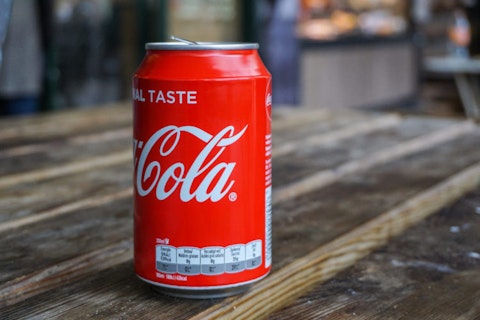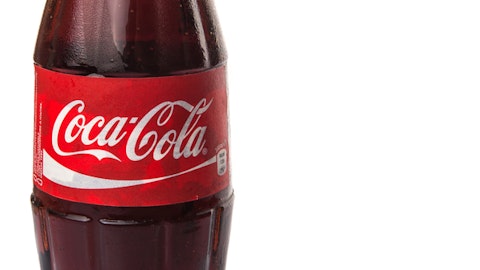Fomento Económico Mexicano, S.A.B. de C.V. (NYSE:FMX) Q3 2023 Earnings Call Transcript October 27, 2023
Operator: Hello, and welcome to the FEMSA’s Third Quarter 2023 Results Conference Call. Please note this conference is being recorded. And for the duration of the call, your lines will be on listen-only. However, you’ll have the opportunity to ask questions. [Operator Instructions] I will now hand you over to Juan Fonseca to begin today’s conference. Thank you.
Juan Fonseca: Good morning, everyone. Welcome to FEMSA’s third quarter 2023 results conference call. Today, we are joined by Paco Camacho, our Chief Corporate Officer; Eugenio Garza, our CFO; and Jorge Collazo, who heads Coca-Cola FEMSA Investor Relations team. The plan is for Paco to open the conversation with some high level of strategic comments on trends and results, followed by Eugenio, who will focus more on the detailed numbers, and we will then open the call for your questions. Paco, please go ahead.

Paco Camacho: Thank you, Juan. Good morning, everyone. Let me begin by thanking you once again for all your kind messages of support and sympathy around the passing of Daniel last quarter. He left a big hole for us, but also a big legacy and we renewed purpose to continue what he starts. To that end, Jose Antonio transition seamlessly and is now fully engaged in his dual role as Chairman and CEO, steering the ship as we continue to execute our ambitious strategy. On that note, and as an update on where we are on FEMSA Forward, we can inform you that regarding the Envoy IFSBrady transaction announced at the end of August, the regulatory process has advanced according to schedule, and we expect the transition to close soon. Additionally, we have launched the divestiture process for the next layer of assets, including those related to Solistica and Inder [ph], and we have already made progress on those early efforts.
Furthermore, last month, we announced changes to FEMSA’s senior leadership team, as well as an evolution of the organizational structure of our retail business vertical. Once these changes take effect in November, we will have one leader for each of the three-fold business verticals in full consistency with FEMSA Forward, enabling our organization to operate with maximum focus and effectiveness. As we have mentioned before, FEMSA Forward is fully aligned with FEMSA’s customer centricity and our broader strategic priorities of driving long-term growth, increasingly enabled by digital capabilities all the way within our core business verticals and with a disciplined approach to capital allocation. On this last topic, we have made significant progress in our analysis, and we will share and discuss our filings with our Board coming November.
We are all aware that this is an item top of mind, and we will keep you posted as appropriate. Moving on to the results. Our third quarter numbers continued the very positive trends seen during the first half of the year. Fully consistent with our strategic priorities and making progress towards the target set by each business unit long-range plan. Indeed, 2023 is shaping up to be a banner year for our core business vertical. Beginning with Proximity, like we did in our call last quarter, it’s helpful to talk for a minute, their own long-range plan and the four priorities around, which it is built; strengthening the core, developing new growth avenues, developing multiple successful formats and growing the footprint beyond Mexico. Looking at OXXO third quarter results through this lens, we see they again made stellar progress strengthening the core as same-store sales growth remained above 15% against a demanding comparison base with average traffic contributing more than half of the growth, which is remarkable.
This strong performance continues to be driven by a broad set of tailwinds including a strong consumer demand for third, gathering and nations, solid commercial income dynamics, better segmentation at the store and the rapid adoption of a spin premier loyalty program. Continuing with the positive news of a stronger core, store growth was robust once again with Mexico and LatAm adding 293 net new stores during the quarter and 1,453 during the past 12 months. Looking only at Mexico, we are on pace to meet or exceed the 1,000 new net store threshold for the first time since before the COVID pandemic and with more productive stores. Moving on to the long-range priority of growing beyond Mexico. During the quarter, Grupo Nos continued its solid advance with revenues increasing over 150% year-over-year and with OXXOs footprint in Brazil more than doubling during the last 12 months [ph] Proximity America, but along the priority of developing multiple successful formats, Bara grew revenues by 36.7% and reached a total of 309 stores as of the end of the quarter.
For its part, proximity Europe increased revenues by 8.7%, reflecting traffic recovery and positive pricing initiatives as well as the growth of Valora food service and B2B business. As of the end of the period, Proximity Europe has 2,810 points of sale. Our health operations continued the trend we saw in the first half of the year. Reflecting foreign exchange headwinds from a strong Mexican peso relative to local currencies in South America as well as mixed results with flat numbers in Chile and positive trends in Colombia and Ecuador offset by pressure in a more competitive Mexico. Importantly, during the quarter, our health business continues to push to consolidate its competitive position across several markets, increasing its footprint by 9% and to reach a total of 4,247 locations.
In fact, during the last year, our Shell division added new locations across its territories at a pace of MXN1 per day. For its part, our fuel business delivered a stable performance with the strength in the corporate wholesale business continuing to perform relative to region outperformed relative to region. Regarding digital, the number of active users for Spin reached $6.4 million during the quarter. An active user for our Premier loyalty program reached $17.7 millionwhile more than 28% of OXXO Mexico sales are now associated with the program. We continue to privilege the acquisition of higher-quality users while we make progress fine-tuning the use cases, value proposition, unit economics and monetization strategies for each part of the ecosystem.
In terms of financial implications, during the quarter, we deployed close to MXN 1 billion in growing this business, roughly in line with the previous quarter as well as budget. Finally, Coca-Cola FEMSA delivered a remarkable set of results for the third quarter, driven by double-digit volume and revenue growth as they accelerate their pace of investment across markets. And with that, let me turn it over to Eugenio.
Eugenio Garza: Thank you, Paco, and good morning to everyone on line. Before going on to the numbers, I also want to give a quick shot out to our colleagues in Acapulco and surrounding areas that were affected by Hurricane Otis. There have been true heroes in helping the community to get back on their feet over the past couple of days. Thank you for that. Going into the results in more detail, I also want to bring your attention before that, that — as of the third quarter, we are now booking onboard solutions as of the discontinued operations. Therefore, for comparability purposes, we are adjusting our third quarter ’22 consolidated financials to reflect this change. Moving on to FEMSA’s consolidated quarterly results. Total revenues during the third quarter increased 19.3% and while income from operations increased 12.7% compared to the third quarter of 2022.
Net consolidated income was MXN 12.8 million billion, reflecting higher income from operations a non-cash foreign exchange gain of $5.4 billion related to FEMSA’s U.S. dollar denominated cash position as impacted by the depreciation of the Mexican peso during the quarter and a decrease in net interest expenses during the quarter. This was offset by a decrease in our net income from discontinued operations, which mainly reflects the results of our investment in Heineken during third quarter 2022. Moving on to discuss our operations and beginning with proximity Americas. We added 283 units during the quarter to reach 1,453 net new stores for the last 12 months. This puts us ahead of target and underscores not just the momentum we have achieved in Mexico, but also the strong pace we now have in Latin America, particularly in Colombia, where we recently began opening stores in our fourth city Cali.
OXXO in-store sales were up 15.1% for the third quarter, This was driven by an increase of 6.6% in average customer ticket and a very strong 8% growth in traffic. As Paco mentioned at the outset, this performance reflects a broad set of tailwinds related to core categories performing well. Healthy commercial income dynamics, better segmentation efforts and the growing impact of the Premier loyalty program, all of this against the backdrop of a robust consumer environment. Gross margin expanded by a full percentage point to reach 41.2%, reflecting strong commercial activity and promotional programs with key suppliers as well as an undemanding comparison base from last year. Income from operations increased 14.7%, while operating margin decreased 50 basis points compared to the same period of 2022 to reach 8.9%, reflecting an increase in labor expenses stemming from the labor reforms in Mexico.
At Proximity Europe, revenues increased 8.7% in local currency to reach MXN 11.2 billion, reflecting a recovery in traffic and ticket, driven mostly by improved customer mobility. Gross margin was 41.8%, reflecting a mix effect driven by the positive performance of Valora’s foodservice and B2B businesses. Operating margin was 3.1%, reflecting better operating leverage, partially offset by an increase in expenses driven by inflationary pressures. Moving on to FEMSA’s Health operations. During the quarter, we expanded our drug store count by 80 net new additions to reach a total of 4,347 units across all of our territories at the end of September and 365 total net new stores for the last 12 months. Revenues increased slightly, while same-store sales decreased an average of 3.6%.
However, as was the case last quarter, it is important to note that on a currency-neutral basis, revenues would have grown 13.6% and same-store sales would have increased 4.7%, partially offset by a demanding comparison base in our operations in Chile and a very challenging competitive environment in Mexico. Gross margin contracted 30 basis points in the quarter, reflecting a negative mix effect, driven by the increasing contribution of our operations in Colombia, which have structurally lower margin. Operating margin increased 60 basis points, reflecting an increase in labor expenses in most of our markets. At OXXO gas, revenues increased 14.2% and same-station sales grew 8.1%. Retail volumes were again complemented by a robust pickup in corporate and wholesale activity.
During the quarter, gross margin was 12.4%, while operating margin was 4.5%, reflecting tight expense control, offset by increased labor expenses. Moving on, Coca-Cola FEMSA, as you saw a couple of days ago, delivered a stellar set of results in the third quarter. Total volume grew 11.6%, driven by growth across all of its territories. Total revenues increased 10.1% and operating income grew 15.3% as operating margin expanded by 70 basis points to reach 13.5%. You can listen to the replay of their conference call held last Wednesday on their Investor Relations website. And with that, let us open the line up for questions. Operator, please?
See also 20 States with the Highest Alcohol and Beer Tax and 12 Best Performing NASDAQ Stocks in 2023.
Q&A Session
Follow Fomento Economico Mexicano S (NYSE:FMX)
Follow Fomento Economico Mexicano S (NYSE:FMX)
Operator: Thank you. [Operator Instructions] Our first question comes from the line of Ben Theurer from Barclays. Please go ahead. Ben Theurer from Barclays. Please go ahead. Our next question comes from the line of Ricardo Alves from Morgan Stanley. Please go ahead.
Ricardo Alves: Hi everyone. Thanks so much for the call. Thanks for the quick update on capital allocation as well. I’ll leave follow-ups on that to another colleague. I wanted to take advantage of such strong topline at OXXO as well as the new leadership with Jose Antonio in the Retail vertical. I wanted to take advantage of that and try and ask a more strategic question. I mean, FEMSA opened nearly 300 stores this quarter, right? We’re running at 1,500 last 12 months. So in the context of the FEMSA forward announcement, the prominence that OXXO is gaining the senior management changes, is there a revised medium to long-term growth plan for OXXO? Wanted to see if you can break it down again into what are the latest thoughts for Mexico, South America, ex-Brazil and even Brazil, if you will, but mostly proximity Americas?
Basically, after these numbers quarter-over-quarter of beats on the topline front, we feel that there’s upside to the numbers that we’ve discussed over and over again over the past couple of quarters. So, just curious to hear the latest strategic thoughts ahead for OXXO coming from Jose Antonio and the proximity team overall? And then I’ll go back in the queue. thank you.
Paco Camacho: Thank you. Thank you, Ricardo, for the question. Not sure what it means to go back in the queue, but thank you. I’ll just start with the first part of–
Ricardo Alves: I want to limit myself to one question.
Paco Camacho: I know. Thanks for the discipline. Listen, let me start with the first part of the question, and I will let then can you provide a bit more color. But look, on the strategic side, clearly, the good news here is that on top of the goodness of the organizational alignment with [indiscernible], which is taking place as we said in November. The fact is that we have also shared with you, we have very robust long-range plans on each of the businesses, including, of course, proximity. So as of today, what is happening is that all the plans that were developed behind that long-range plan strategy, are being deployed. And every single one of them are providing results and some of those results are, of course, part of what is being reported.
Now as we work right now in the budget for 2024, as we closed 2023, you can imagine that part of the exercise is to also revise or revisit the projection that was done for the next several years as part of the long-range plan. And the team is working on that. And I assure you that when – with José coming in, he’s actively participating in reviewing those numbers and in checking whether they need to adjust some of the strategies, how they will start working together. So I mean, clearly, is part of the very robust process that we have in FEMSA related to the long-range plan to the budget to the business management and José is jumping in at the right moment to make sure that any adjustment is taking care of as part of that process. As for the second part of the question, Juan, yeah
A –Juan Fonseca: Yes. Hey, Ricardo, it’s Juan. I think in terms of the number of openings, as you correctly framed the question, this is pretty strategic in the following sense. The last couple of years, certainly through the COVID years, there was this big deceleration in the opening of stores in Mexico, right? We closed a bunch of stores, and then we were opening 800 per year. And obviously, there was this concern of — does this mean that structurally, we can’t go back to kind of the four-digit number of openings in Mexico. And of course, what we’ve seen in the last 18 months to 24 months is once we build our pipeline with the new standards that are allowing us to open better and more productive stores, we are already back to the 1,000 stores per year in Mexico.
And I think at this point, that is the number that I would plug into a model. I don’t know necessarily that we would go back to the 1,200, 1,300, 1,400 that we did at some point in Mexico. I think I would use the 1,000 number for Mexico. But the other part of the equation, which is LatAm has definitely come of age over that time frame as well. So we mentioned a few minutes ago, we are now in four markets in Colombia. So it’s Bogota, Bucaramanga, Pereira and now Cali. And things are going well and you integrated okay market in Chile, there’s going to be some further growth there as well. And of course, Peru is also kind of coming into a stage where we could probably accelerate the openings. So if you look at it in an aggregate numbers. So the 1,400 and change, that number will probably continue to increase, but it will be more driven by ex-Mexico than by Mexico.
And I would leave Mexico at 1,000 until further notice. But again, remembering that those 1,000 stores are going to be more productive than the 1,000 stores that we opened two, three, four, five years ago. I would leave it there.
Eugenio Garza: The only thing I would add just to get on to move on here, but I think it’s important is that as we continue to execute on the long range plan, we are having success across all initiatives. I mean top line initiatives, bottom lines initiatives. And that is making, I think, the unit economics, especially in Mexico, better than we thought they would be when we originally executed. So if anything, I see a longer runway in terms of how long we can grow at this pace, and I think poses challenge going forward would be more of a bandwidth issue as to how we allocate I mean, human power and just — I mean, bandwidth to prioritize across all the regions that are now encompass what he is managing. So it’s more a prioritization issue than anything else. And I’m comfortable that – that we would be able to grow the pace – product for longer than we otherwise would have with the old unit economics.
Paco Camacho: And this — none of this really includes Brazil, right? I mean Brazil is its own thing. And there, I would also envision an acceleration of the pace.
Ricardo Alves: Very clear. Thanks for the comprehensive answer everybody.
Eugenio Garza: Thank you.
Operator: Our next question comes from the line of Ben Theurer from Barclays. Please go ahead.
Ben Theurer: Okay. I will try this again. Can you hear me?
Eugenio Garza: Yes. Perfect, Ben. Thank you.
Ben Theurer: Fantastic. So first of all, congratulations on the results. And I’d like to ask my question on just capital allocation in general. We talked right now about store openings for OXXO, you’ve talked about the health piece one per day, nice number 365 in the last 12 months. So if we think about these CapEx plans, right, and obviously, the cash you need for being that base new stores, be it OXXO, be it health in the different regions. How should we think about just your cash flow allocation and just the general allocation of the excess capital that you have right now post-M&A? Any update you can give us on that, that would be much appreciated.
Eugenio Garza: Sure. Let me take that Ben, and then you guys can complement me if you want. I mean, the true beauty of the proximity health model from a capital allocation perspective is that they are true compounders. I mean they generate a lot of cash, and we are at a store base right now in all geographies that pretty much self-fund this growth at very high marginal voice. So it is a fantastic business model at this stage we’re in. So we could be — I mean, over the next five years, be spending, I mean, $4 billion to $5 billion of growth CapEx, not just in new store openings, but also distribution centers and now the infrastructure that will be self-funding by the business unit and still have enough cash left over for distributions to shareholders.



